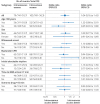Intraosseous versus intravenous vascular access in upper extremity among adults with out-of-hospital cardiac arrest: cluster randomised clinical trial (VICTOR trial)
- PMID: 39043416
- PMCID: PMC11265210
- DOI: 10.1136/bmj-2024-079878
Intraosseous versus intravenous vascular access in upper extremity among adults with out-of-hospital cardiac arrest: cluster randomised clinical trial (VICTOR trial)
Abstract
Objective: To compare the effectiveness of intraosseous versus intravenous vascular access in the treatment of adult patients with out-of-hospital cardiac arrest.
Design: Cluster randomised controlled trial.
Setting: The VICTOR (Venous Injection Compared To intraOsseous injection during resuscitation of patients with out-of-hospital cardiac arrest) trial involved emergency medical service agencies with all four advanced life support ambulance teams in Taipei City, Taiwan. The enrolment period spanned 6 July 2020 to 30 June 2023 and was temporarily suspended between 20 May 2021 and 31 July 2021 owing to the covid-19 pandemic.
Participants: Adult (age 20-80 years) patients with non-traumatic out-of-hospital cardiac arrest.
Interventions: Biweekly randomised clusters of four participating advanced life support ambulance teams were assigned to insert either intravenous or intraosseous access.
Main outcome measures: The primary outcome was survival to hospital discharge. Secondary outcomes included return of spontaneous circulation, sustained return of spontaneous circulation (≥2 hours), and survival with favourable neurological outcomes (cerebral performance category score ≤2) at hospital discharge.
Results: Among 1771 enrolled patients, 1732 (741 in the intraosseous group and 991 in the intravenous group) were included in the primary analysis (median age 65.0 years; 1234 (71.2%) men). In the intraosseous group, 79 (10.7%) patients were discharged alive, compared with 102 (10.3%) patients in the intravenous group (odds ratio 1.04, 95% confidence interval 0.76 to 1.42; P=0.81). The odds ratio of intraosseous versus intravenous access was 1.23 (0.89 to 1.69; P=0.21) for pre-hospital return of spontaneous circulation, 0.92 (0.75 to 1.13; P=0.44) for sustained return of spontaneous circulation, and 1.17 (0.82 to 1.66; P=0.39) for survival with favourable neurological outcomes.
Conclusions: Among adults with non-traumatic out-of-hospital cardiac arrest, initial attempts to establish vascular access through the intraosseous route did not result in different outcomes compared with intravenous access in terms of the proportion of patients surviving to hospital discharge, pre-hospital return of spontaneous circulation, sustained return of spontaneous circulation, and favourable neurological outcomes.
Trial registration: NCT04135547ClinicalTrials.gov NCT04135547.
© Author(s) (or their employer(s)) 2019. Re-use permitted under CC BY-NC. No commercial re-use. See rights and permissions. Published by BMJ.
Conflict of interest statement
Competing interests: All authors have completed the ICMJE uniform disclosure form at https://www.icmje.org/disclosure-of-interest/ and declare: this study was supported by the Taiwan Ministry of Science and Technology, National Science and Technology Council, and National Taiwan University Hospital, Yun-Lin Branch; no financial relationships with any organisations that might have an interest in the submitted work in the previous three years; no other relationships or activities that could appear to have influenced the submitted work.
Figures



References
-
- Virani SS, Alonso A, Aparicio HJ, et al. American Heart Association Council on Epidemiology and Prevention Statistics Committee and Stroke Statistics Subcommittee . Heart Disease and Stroke Statistics-2021 Update: A Report From the American Heart Association. Circulation 2021;143:e254-743. 10.1161/CIR.0000000000000950 - DOI - PubMed
-
- Panchal AR, Bartos JA, Cabañas JG, et al. Adult Basic and Advanced Life Support Writing Group . Part 3: Adult basic and advanced life support: 2020 American Heart Association Guidelines for cardiopulmonary resuscitation and emergency cardiovascular care. Circulation 2020;142(suppl_2):S366-468. 10.1161/CIR.0000000000000916 - DOI - PubMed
Publication types
MeSH terms
Associated data
LinkOut - more resources
Full Text Sources
Medical
